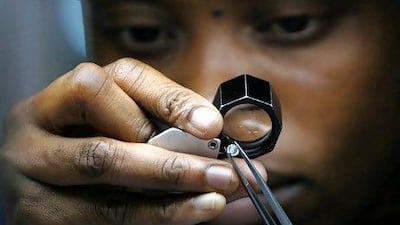For first-time investors in diamonds, there's a lot to consider before taking the leap into the world of precious gems. Ashraf Ahmed, the managing director of Diamond Infinity DMCC, a Dubai-based wholesale merchant, says diamonds are a tangible, portable and liquid investment. Their value, he says, is based on their rarity, which can fluctuate with the discovery of new sources and the exhaustion of old mines. However, they are considered a risk-free investment when compared with the changing value of gold.
1 The basics
Diamonds are formed over a period of a billion or more years deep within Earth's crust - about 150 kilometres deep - and are pushed to the surface by volcanoes. Most diamonds are found in volcanic rock, called Kimberlite, or in the sea after having been carried away by rivers when they were pushed to the surface.
A diamond is 58 times harder than the next hardest mineral on Earth, corundum, from which rubies and sapphires are formed. During the 15th century, it was discovered that the only way to cut diamonds was with other diamonds. Yet, diamonds are brittle. If hit hard with a hammer, a diamond will shatter or splinter.
2 Learn about diamonds
The essentials are the four Cs: carat, colour, clarity and cut. Carat is the measurement of the weight of a diamond and is equal to 0.2 grams. Colour ranges from D to Z (D is the best colour and Z leans towards the fancy colours). Clarity starts at flawless and goes to I3 (from no inclusions to inclusions that are visible to the naked eye). Cut goes from excellent to poor and refers to the diamond's reflective qualities, not its shape.
3 Other elements to consider
It's not just about the four C's. In addition to this, investors must look at the proportion, symmetry and polish of the diamond they wish to purchase. These are clearly stated on all certificates. Proportion refers to the cut of the diamond and thus its sparkle, which is caused by light refraction. Symmetry applies to the "exactness" of the shape of the diamond, including facets such as its arrangement and placement. Polish is all about the quality of a diamond's surface condition that was achieved through the polishing process.
4 Fluorescence
This is something that 90 per cent of diamond buyers are not aware of. If you are buying a diamond that has a high colour, such as a D, E, F, G, or H, the fluorescence should be nil or faint. This is because fluorescence indicates that there is carbon present within the diamond, which will make it look less shiny and "milky". Fluorescence robs a diamond of its true lustre and colour. However, if you are considering buying colours other than the above, such as J, K, L, M, or N, then the fluorescence is highly valued because it makes the diamond look brighter and whiter than its true colour.
5 Budget for your investment
Investors need to start by assessing how much they can afford to invest and then what category of diamond will fit within their budget. They must also identify whether or not they want to buy loose certified diamonds or diamond jewellery. The reason for this is that loose diamonds are more liquid, which can help if you need to sell one quickly.
6 Long-term holding
It is very important to look at diamonds as a long-term investment. Their appreciation is strongly evident, while the supply of diamonds is expected to decrease over the coming years.
7 Prices
Diamond prices are expected to increase exponentially over the coming years. According to analysts at Money Watch, diamond demand is set to grow at 20 per cent a year, which means now is a good time to invest in diamonds.
8 Wearability
There's not many investments that can be worn and used for years without diminishing their value. This is one of the great features about investing in diamonds - one can buy these dazzling rocks, use them for years and, if need be, sell them.
9 Wholesale versus retail
Try to buy wholesale and not retail. The reason for this is because the profit margins for diamonds sold retail are quite high.
10 Certification
It is important to have your diamond certified because this confirms such things as its carat and grade. There are three widely used diamond laboratories that certify diamonds: the California-based Gemological Institute of America, HRD Antwerp, in Belgium, and the International Gemological Institute (IGI), which is also headquartered in Antwerp, but has an office in Dubai.

